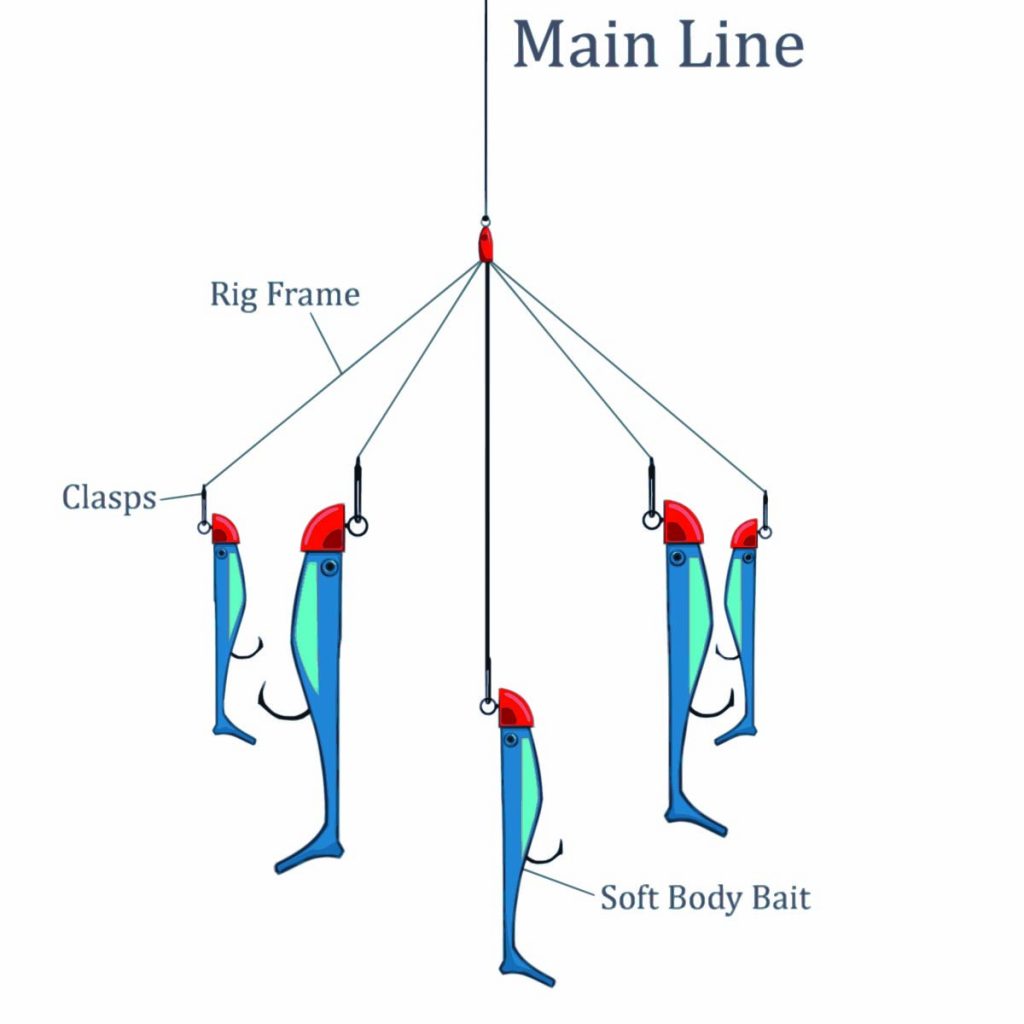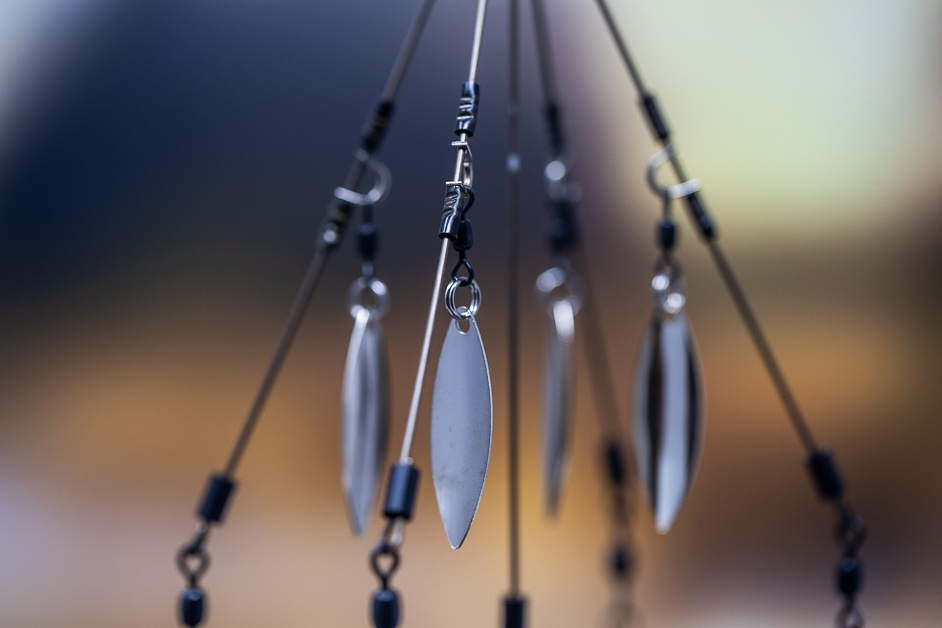Umbrella rig fishing is one of the most controversial techniques. It is even considered illegal to fish with a rig that holds more than three hooks in some states, such as Iowa, Kansas, Maryland, Massachusetts, Minnesota, Nebraska, Nevada, New Hampshire, and Vermont. However, the umbrella rig is nevertheless an interesting and helpful fishing approach that combines multiple lures for multiple catches.
It first came to the attention of the bass fishing audience when Paul Elias used an umbrella rig to win the FLW Tour Open on Lake Guntersville in 2011. Opinions are divided about the rig, so we’ll leave it to you to decide whether it is something you want to add to your fishing gear. Despite the controversy, the rig is highly effective and inspired by similar setups that have been used for decades by commercial saltwater trollers. Here’s an overview of how and when to use an umbrella rig to make the most of your bass fishing outing.
What is an Umbrella Rig?
While umbrella rigs are not a novelty, castable umbrella rigs have been used for only a decade in the bass fishing world. Anglers refer to these also as A-rigs for Alabama rigs, which was first designed by Andy Poss. Typical trolling rigs are heavy and designed to be trolled on wireline, while the castable umbrella rig is specifically modeled to be lighter and cast-friendly.
The principle of the umbrella rig is that it holds multiple baits on wire arms, enabling anglers to cast a school of baits. The term umbrella refers to the shape of the rig, which reminds the many ribs of the rain-catching device. There is no one type of umbrella rig, as the baits will be arranged differently to accommodate for the weight and effects each fisher wants to achieve in relation to the depth of the water column and the different conditions. The rig is universally used across the United States in southern and northern waters, either to catch bass during the cool water months or to target smallmouths.
You will typically find five wires all coming from a single point, including four outer wires and one center wire, which is longer than the rest. Umbrella rigs can come in both bladed and non-bladed versions, although models with blades are more popular. Anglers can modify the configuration to meet the requirements of different situations, including using longer arms, adding extra arms to have enough rigs for up to nine baits, using a number of blades on each arm, etc. The most common umbrella rig modifications tend to focus on the length of the arms and the number of blades. If you choose to use an umbrella rig in a tournament or in various states, you might need to modify the rig accordingly to obey the regulations.
Traditionally, umbrella rigs carry both real baits with hooks and dummy baits.
Best Umbrella Rig Setup
The type of setup you use for an umbrella rig will depend entirely on your fishing intentions and experience. Professional anglers who want to catch big fish tend to prefer long rods. They will target 8’ to 9’ rods that are typically set for heavy to extra heavy action. If you are new to using umbrella rigs, however, 7’0” to 7’6” rod models with medium to heavy action are a better choice. Smaller rods are much more comfortable if you wish to fish for a longer period of time! Typically, if you are unsure which rod to pick, we recommend this simple rule: Use more rod for a heavy rig, and less rod for a lighter rig.
Initially, umbrella rigs were first seen with heavy duty braided lines, 50 pound line. You will still be able to spot braided line users, but most anglers prefer a 16 to 20 pound fluorocarbon line for clear water smallmouths. Comparatively, a braided line will allow added sensitivity, so you can feel even when the bass swipe the baits without getting hooked. The fluorocarbon model, on the other hand, is much more forgiving and maneuverable. At this point, comfort and experience will determine which line is best suited for your fishing style.
On average, umbrella rig users recommend a 300 casting reel for medium heavy to heavy duty rig. Ultimately, the weight of your umbrella rig will determine whether you should for a heavy duty or a standard bass reel. Most anglers prefer a 6:1 to 7:1 ratio to catch up with the fish that bite and swim and maximize cast and line capacity. If you are using an extra-long rod, you’ll want a baitcaster in a lower gear ratio, 5.4:1.
How to Fish an Umbrella Rig
Adding a leader to your umbrella rig can make a great deal of difference and improve the drawing power of the umbrella rig. We suggest 6’ to 9’ leaders as anything longer would make the umbrella rig more cumbersome to cast. With a shorter cast, you can maintain the standard lob-style cast for the rig.
It’s important to remember that the umbrella rig presents many lures simultaneously, which is why you want to add variations to create a realistic effect. You do not need to emulate trolling when using a castable umbrella rig. On the contrary, you can apply some of the techniques that are more suited to fishing lures. Letting the rig drop deep as you would with spinnerbait fishing can accentuate the movement of the blades – if you are using blades.
The pause n’ go technique is also a popular choice with chatterbait fishing and can be equally effective with an umbrella rig. This will work best in shallow areas where reproducing the stutter motion of the shad on the water surface or next to the surface will appeal to the bass.
A slow roll technique will give plenty of time for lethargic fish in cold waters to chase and bite. It’s important to practice the slow retrieve and make sure you can feel the blades – if you are blades – moving. Ideally, the addition of some blades will help attract bass out of their hiding spots with the slow rolling.
Similar to other fishing lures, you can also run an umbrella rig with a near ripping technique, which allows you to let the rig sink and move slowly near cover between yanking it up. The sudden movement paired with the vibrations from the blades can work in getting bass out of the cover.
When to Fish an Umbrella Rig
The design of the umbrella rig encourages successful catches in most areas, as long as you can target these with sufficient lures. As it’s not a bait that requires a specific situation to work, anglers can use it almost anywhere. As the rig can imitate any type of bait, it’s suited for both shad heavy areas and other baitfish areas.
Due to the nature of the rig, you’ll find it is especially effective in catching lethargic fish in cold water, or during the pre-spawning season. You will equally find high success when the fish are actively hunting too, although you might prefer to use a different fishing lure for the love of sports! Careful, however, to stick to the fishing law in each location, as some states will not allow anglers to use umbrella rigs with more than three hooks.
Umbrella rigs can be used in water columns of all depths and clarity and can catch in both largemouth and smallmouth lakes. Therefore, the sky is pretty much the limit when it comes to how you should use the rig. From docks to breaks in main lakes, umbrella rigs are relevant anywhere baitfish are present. You can cast them along riprap banks, in shallow coves, and in deep brush and structure of water.
Best Lure for Umbrella Rigs
The umbrella rig can be customized to meet most conditions. Therefore, choosing the best lure for your rig depends on the situation. Ideally, you want to match the lure to the dominant forage, but most anglers recommend experimenting with different color schemes on the same rig. It’s the quickest and safest way to figure out what works in each situation.
Shad imitations are among the most popular lures for umbrella rigs, so you want to aim for pearl and shad styles. However, this will vary depending on the water clarity and depth. If the water is dirty or stained, you will find that chartreuse color is more effective. Any baitfish imitation color is effective, but you’ll find a higher success rate if you include a little red and bright among your lures as soon as you target deeper areas.
In muddy and deep water, blades are always a good idea. But you can skip those in very clear water to focus on lure colors and sizes.
Ideally, you want to match the jig head to the swimbait you’re using. You can have a big catch with relatively small baits, 3’5” or shorter, so there isn’t always a need to pick anything too large. More often than not, smaller swimbaits with small 1/8oz jig heads are among the most effective for both smallmouth and bigmouth areas.
This umbrella rigs guide can provide you with a starting point to maximize your catch. Experimenting with umbrella rigs is key to figure out what works for you, in terms of technique, water areas, seasons, and lure strategies. Anglers have proven they can catch big in shallow and deep environments throughout the year!
















